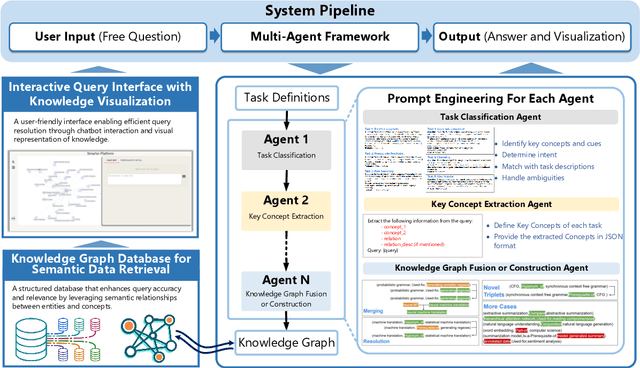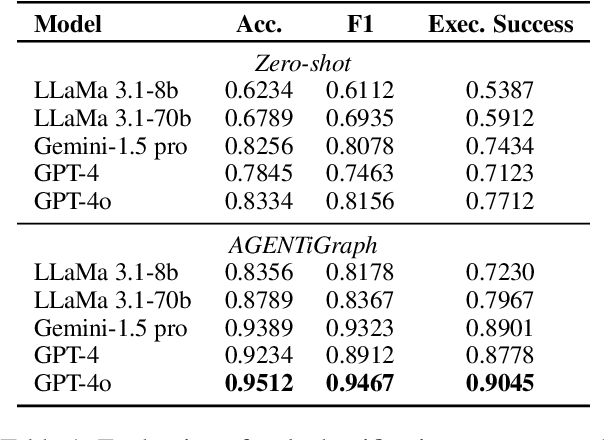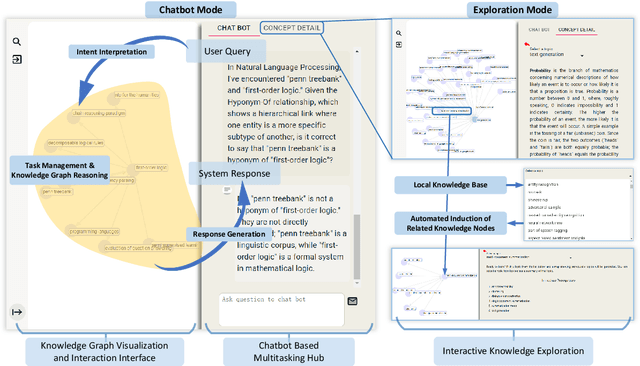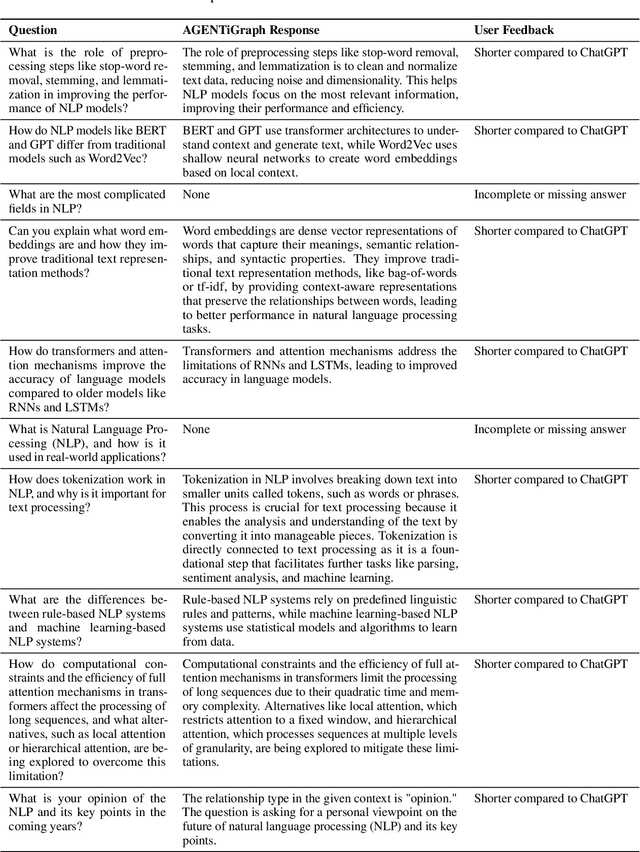Irene Li
HealthGenie: Empowering Users with Healthy Dietary Guidance through Knowledge Graph and Large Language Models
Apr 20, 2025Abstract:Seeking dietary guidance often requires navigating complex professional knowledge while accommodating individual health conditions. Knowledge Graphs (KGs) offer structured and interpretable nutritional information, whereas Large Language Models (LLMs) naturally facilitate conversational recommendation delivery. In this paper, we present HealthGenie, an interactive system that combines the strengths of LLMs and KGs to provide personalized dietary recommendations along with hierarchical information visualization for a quick and intuitive overview. Upon receiving a user query, HealthGenie performs query refinement and retrieves relevant information from a pre-built KG. The system then visualizes and highlights pertinent information, organized by defined categories, while offering detailed, explainable recommendation rationales. Users can further tailor these recommendations by adjusting preferences interactively. Our evaluation, comprising a within-subject comparative experiment and an open-ended discussion, demonstrates that HealthGenie effectively supports users in obtaining personalized dietary guidance based on their health conditions while reducing interaction effort and cognitive load. These findings highlight the potential of LLM-KG integration in supporting decision-making through explainable and visualized information. We examine the system's usefulness and effectiveness with an N=12 within-subject study and provide design considerations for future systems that integrate conversational LLM and KG.
Exploring the Role of Knowledge Graph-Based RAG in Japanese Medical Question Answering with Small-Scale LLMs
Apr 16, 2025Abstract:Large language models (LLMs) perform well in medical QA, but their effectiveness in Japanese contexts is limited due to privacy constraints that prevent the use of commercial models like GPT-4 in clinical settings. As a result, recent efforts focus on instruction-tuning open-source LLMs, though the potential of combining them with retrieval-augmented generation (RAG) remains underexplored. To bridge this gap, we are the first to explore a knowledge graph-based (KG) RAG framework for Japanese medical QA small-scale open-source LLMs. Experimental results show that KG-based RAG has only a limited impact on Japanese medical QA using small-scale open-source LLMs. Further case studies reveal that the effectiveness of the RAG is sensitive to the quality and relevance of the external retrieved content. These findings offer valuable insights into the challenges and potential of applying RAG in Japanese medical QA, while also serving as a reference for other low-resource languages.
JiraiBench: A Bilingual Benchmark for Evaluating Large Language Models' Detection of Human Self-Destructive Behavior Content in Jirai Community
Mar 27, 2025Abstract:This paper introduces JiraiBench, the first bilingual benchmark for evaluating large language models' effectiveness in detecting self-destructive content across Chinese and Japanese social media communities. Focusing on the transnational "Jirai" (landmine) online subculture that encompasses multiple forms of self-destructive behaviors including drug overdose, eating disorders, and self-harm, we present a comprehensive evaluation framework incorporating both linguistic and cultural dimensions. Our dataset comprises 10,419 Chinese posts and 5,000 Japanese posts with multidimensional annotation along three behavioral categories, achieving substantial inter-annotator agreement. Experimental evaluations across four state-of-the-art models reveal significant performance variations based on instructional language, with Japanese prompts unexpectedly outperforming Chinese prompts when processing Chinese content. This emergent cross-cultural transfer suggests that cultural proximity can sometimes outweigh linguistic similarity in detection tasks. Cross-lingual transfer experiments with fine-tuned models further demonstrate the potential for knowledge transfer between these language systems without explicit target language training. These findings highlight the need for culturally-informed approaches to multilingual content moderation and provide empirical evidence for the importance of cultural context in developing more effective detection systems for vulnerable online communities.
MKG-Rank: Enhancing Large Language Models with Knowledge Graph for Multilingual Medical Question Answering
Mar 21, 2025Abstract:Large Language Models (LLMs) have shown remarkable progress in medical question answering (QA), yet their effectiveness remains predominantly limited to English due to imbalanced multilingual training data and scarce medical resources for low-resource languages. To address this critical language gap in medical QA, we propose Multilingual Knowledge Graph-based Retrieval Ranking (MKG-Rank), a knowledge graph-enhanced framework that enables English-centric LLMs to perform multilingual medical QA. Through a word-level translation mechanism, our framework efficiently integrates comprehensive English-centric medical knowledge graphs into LLM reasoning at a low cost, mitigating cross-lingual semantic distortion and achieving precise medical QA across language barriers. To enhance efficiency, we introduce caching and multi-angle ranking strategies to optimize the retrieval process, significantly reducing response times and prioritizing relevant medical knowledge. Extensive evaluations on multilingual medical QA benchmarks across Chinese, Japanese, Korean, and Swahili demonstrate that MKG-Rank consistently outperforms zero-shot LLMs, achieving maximum 35.03% increase in accuracy, while maintaining an average retrieval time of only 0.0009 seconds.
MMLU-ProX: A Multilingual Benchmark for Advanced Large Language Model Evaluation
Mar 13, 2025Abstract:Traditional benchmarks struggle to evaluate increasingly sophisticated language models in multilingual and culturally diverse contexts. To address this gap, we introduce MMLU-ProX, a comprehensive multilingual benchmark covering 13 typologically diverse languages with approximately 11,829 questions per language. Building on the challenging reasoning-focused design of MMLU-Pro, our framework employs a semi-automatic translation process: translations generated by state-of-the-art large language models (LLMs) are rigorously evaluated by expert annotators to ensure conceptual accuracy, terminological consistency, and cultural relevance. We comprehensively evaluate 25 state-of-the-art LLMs using 5-shot chain-of-thought (CoT) and zero-shot prompting strategies, analyzing their performance across linguistic and cultural boundaries. Our experiments reveal consistent performance degradation from high-resource languages to lower-resource ones, with the best models achieving over 70% accuracy on English but dropping to around 40% for languages like Swahili, highlighting persistent gaps in multilingual capabilities despite recent advances. MMLU-ProX is an ongoing project; we are expanding our benchmark by incorporating additional languages and evaluating more language models to provide a more comprehensive assessment of multilingual capabilities.
ReAgent: Reversible Multi-Agent Reasoning for Knowledge-Enhanced Multi-Hop QA
Mar 10, 2025Abstract:Recent advances in large language models (LLMs) have significantly improved multi-hop question answering (QA) through direct Chain-of-Thought (CoT) reasoning. However, the irreversible nature of CoT leads to error accumulation, making it challenging to correct mistakes in multi-hop reasoning. This paper introduces ReAgent: a Reversible multi-Agent collaborative framework augmented with explicit backtracking mechanisms, enabling reversible multi-hop reasoning. By incorporating text-based retrieval, information aggregation and validation, our system can detect and correct errors mid-reasoning, leading to more robust and interpretable QA outcomes. The framework and experiments serve as a foundation for future work on error-tolerant QA systems. Empirical evaluations across three benchmarks indicate ReAgent's efficacy, yielding average about 6\% improvements against baseline models.
GraphCheck: Breaking Long-Term Text Barriers with Extracted Knowledge Graph-Powered Fact-Checking
Feb 23, 2025Abstract:Large language models (LLMs) are widely used, but they often generate subtle factual errors, especially in long-form text. These errors are fatal in some specialized domains such as medicine. Existing fact-checking with grounding documents methods face two main challenges: (1) they struggle to understand complex multihop relations in long documents, often overlooking subtle factual errors; (2) most specialized methods rely on pairwise comparisons, requiring multiple model calls, leading to high resource and computational costs. To address these challenges, we propose \textbf{\textit{GraphCheck}}, a fact-checking framework that uses extracted knowledge graphs to enhance text representation. Graph Neural Networks further process these graphs as a soft prompt, enabling LLMs to incorporate structured knowledge more effectively. Enhanced with graph-based reasoning, GraphCheck captures multihop reasoning chains which are often overlooked by existing methods, enabling precise and efficient fact-checking in a single inference call. Experimental results on seven benchmarks spanning both general and medical domains demonstrate a 6.1\% overall improvement over baseline models. Notably, GraphCheck outperforms existing specialized fact-checkers and achieves comparable performance with state-of-the-art LLMs, such as DeepSeek-V3 and OpenAI-o1, with significantly fewer parameters.
Graphusion: A RAG Framework for Knowledge Graph Construction with a Global Perspective
Oct 23, 2024



Abstract:Knowledge Graphs (KGs) are crucial in the field of artificial intelligence and are widely used in downstream tasks, such as question-answering (QA). The construction of KGs typically requires significant effort from domain experts. Large Language Models (LLMs) have recently been used for Knowledge Graph Construction (KGC). However, most existing approaches focus on a local perspective, extracting knowledge triplets from individual sentences or documents, missing a fusion process to combine the knowledge in a global KG. This work introduces Graphusion, a zero-shot KGC framework from free text. It contains three steps: in Step 1, we extract a list of seed entities using topic modeling to guide the final KG includes the most relevant entities; in Step 2, we conduct candidate triplet extraction using LLMs; in Step 3, we design the novel fusion module that provides a global view of the extracted knowledge, incorporating entity merging, conflict resolution, and novel triplet discovery. Results show that Graphusion achieves scores of 2.92 and 2.37 out of 3 for entity extraction and relation recognition, respectively. Moreover, we showcase how Graphusion could be applied to the Natural Language Processing (NLP) domain and validate it in an educational scenario. Specifically, we introduce TutorQA, a new expert-verified benchmark for QA, comprising six tasks and a total of 1,200 QA pairs. Using the Graphusion-constructed KG, we achieve a significant improvement on the benchmark, for example, a 9.2% accuracy improvement on sub-graph completion.
Transformers4NewsRec: A Transformer-based News Recommendation Framework
Oct 17, 2024



Abstract:Pre-trained transformer models have shown great promise in various natural language processing tasks, including personalized news recommendations. To harness the power of these models, we introduce Transformers4NewsRec, a new Python framework built on the \textbf{Transformers} library. This framework is designed to unify and compare the performance of various news recommendation models, including deep neural networks and graph-based models. Transformers4NewsRec offers flexibility in terms of model selection, data preprocessing, and evaluation, allowing both quantitative and qualitative analysis.
AGENTiGraph: An Interactive Knowledge Graph Platform for LLM-based Chatbots Utilizing Private Data
Oct 15, 2024



Abstract:Large Language Models~(LLMs) have demonstrated capabilities across various applications but face challenges such as hallucination, limited reasoning abilities, and factual inconsistencies, especially when tackling complex, domain-specific tasks like question answering~(QA). While Knowledge Graphs~(KGs) have been shown to help mitigate these issues, research on the integration of LLMs with background KGs remains limited. In particular, user accessibility and the flexibility of the underlying KG have not been thoroughly explored. We introduce AGENTiGraph (Adaptive Generative ENgine for Task-based Interaction and Graphical Representation), a platform for knowledge management through natural language interaction. It integrates knowledge extraction, integration, and real-time visualization. AGENTiGraph employs a multi-agent architecture to dynamically interpret user intents, manage tasks, and integrate new knowledge, ensuring adaptability to evolving user requirements and data contexts. Our approach demonstrates superior performance in knowledge graph interactions, particularly for complex domain-specific tasks. Experimental results on a dataset of 3,500 test cases show AGENTiGraph significantly outperforms state-of-the-art zero-shot baselines, achieving 95.12\% accuracy in task classification and 90.45\% success rate in task execution. User studies corroborate its effectiveness in real-world scenarios. To showcase versatility, we extended AGENTiGraph to legislation and healthcare domains, constructing specialized KGs capable of answering complex queries in legal and medical contexts.
 Add to Chrome
Add to Chrome Add to Firefox
Add to Firefox Add to Edge
Add to Edge